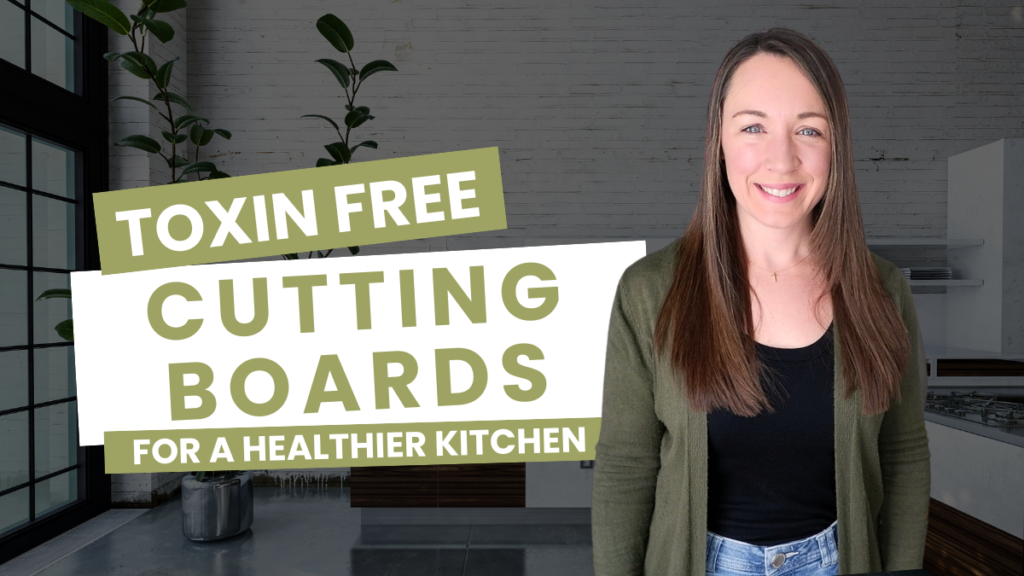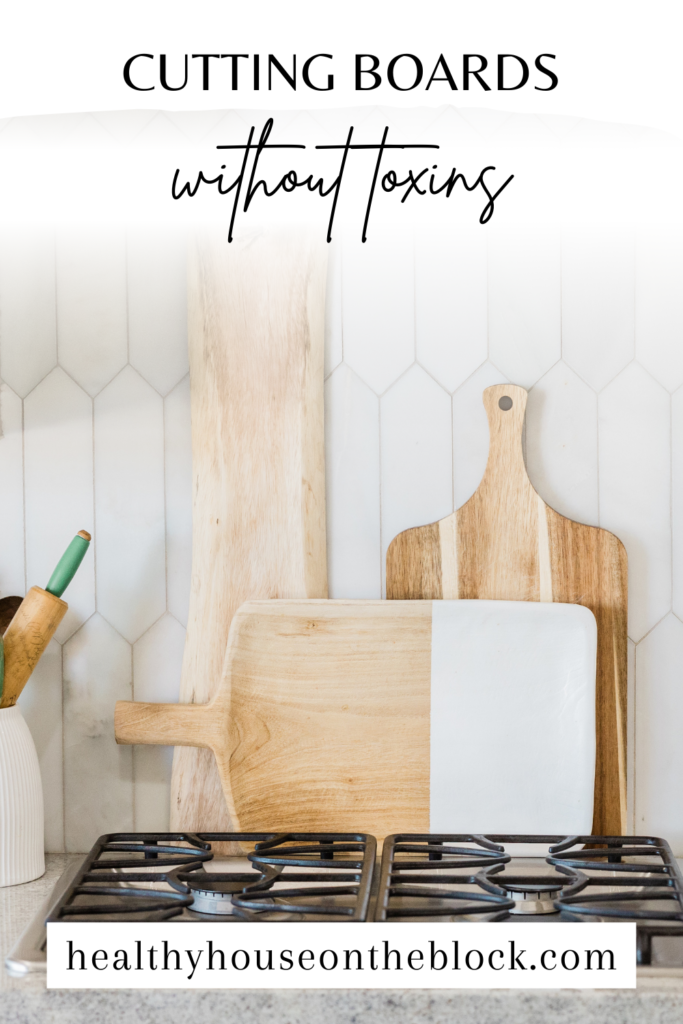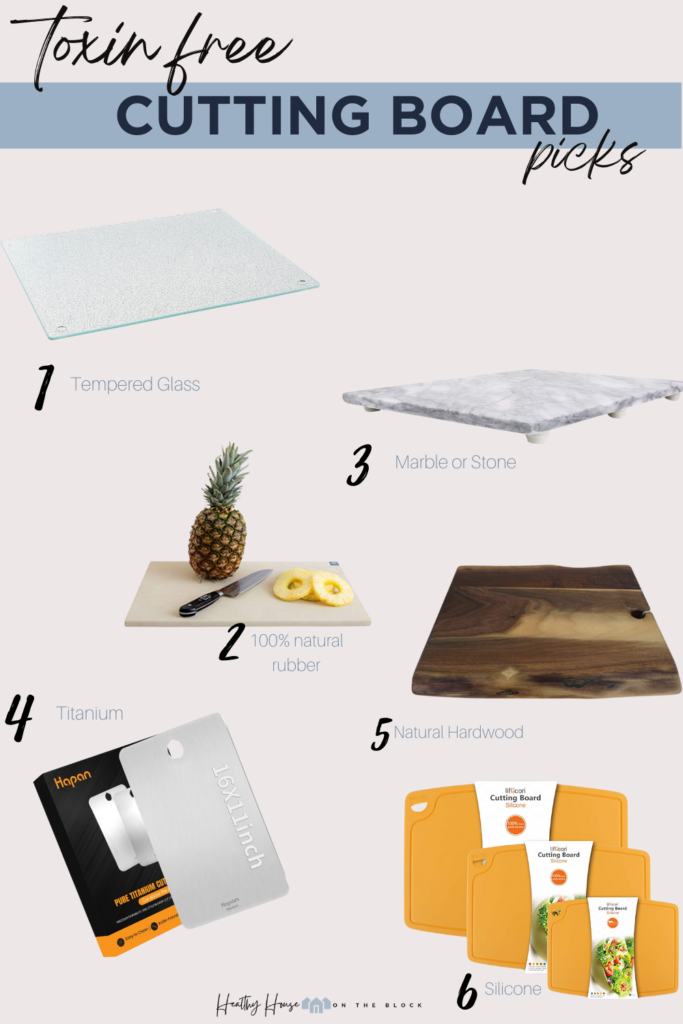
The kitchen seems to be the place I hang out the most when I’m at home, and I’ll be honest, I LOVE it. Cooking and preparing meals is usually something that brings me joy (clean up is another story though). One of the things I do most often in the kitchen is food prep with my cutting board. For a long time I used those plastic, flexible cutting boards, but let’s be honest, after my last few posts about phthalates and polyvinyl chloride, I think you could understand how ditching the plastic cutting board was the ONLY way to go. So what are the best options when it comes to non toxic cutting boards?
And while there are new materials you can choose, there’s always questions about IF it really is a non-toxic cutting board and does it hold up over time. I’m going to share with you everything I know about cutting boards and getting one that is completely safe and healthy for your family. Afterall, you’re cutting up food on it and then consuming that food (and potentially toxins from your cutting board). We know that ingesting toxins is one of the MOST harmful ways they affect our bodies, so making sure food surfaces are safe is key.
The trick to creating a truly toxin free home is not necessarily in a total overhaul process, but instead, in finding lower toxin options to choose WHEN it’s time to replace an item that you use on a frequent basis.
TOXIC CUTTING BOARD SURFACES
Plastic: Plastic is a popular choice for cutting boards, and while it’s pliable and resilient to cuts and scratches, eventually, it does scratch. The plastic that comes into contact with our food is concerned enough due to the toxins in pvc plastic and phthalates that are present in plastic. But add a few scratches and you’ve increased your exposure to these toxins. You’re looking at increasing your risk of endocrine disruption and hormone issues, developmental delays in children, reproductive system harm and an increased risk of allergies and asthma.
Fused Bamboo or Glued Wood: So, let’s clarify, I don’t mean a SOLID, untreated bamboo cutting board. SOme cutting boards that are made of bamboo (and particularly the ones that are lower in price and therefore quality) are actually particles of bamboo fused or glued together. Most of the adhesives must be extra strength in order to hold the particles together, and unfortunately that means the glue often contains formaldehyde, a known carcinogen. Also be careful of non-food grade mineral oil being used as a finish on these, as it contains glyphosate and atrazine, chemicals harmful to the body.
Antibacterial Surface: Any cutting board that has labels stating “Antibacterial” or “Prevents Odors” usually contains some sort of chemical antibacterial agent in or on the board. This could contain triclosan or another similar chemical that disrupts our hormone production as well as creates an environment and system that promotes superbugs. The great news is there are natural elements that have antibacterial properties you can use if bacteria is a large concern.
Melamine: Melamine is a chemical compound commonly found in dishes and kitchen items. Melamine has negative impacts on brain development as well as reproductive functions due to its suppression of the endocrine system. While it’s usually an inexpensive option, due to the chemicals present, it should be avoided when it comes to food preparation.

WHY IT MATTERS TO CHOOSE NON TOXIC CUTTING BOARDS
Ingesting toxins is one of the most harmful ways to expose your body to dangerous chemicals. When you eat, any toxins on your cutting board go straight to your organs, quickly affecting your health and even upsetting your gut microbiome. Here’s how common toxins found in cutting boards can impact you:
Phthalates & Microplastics
- Phthalates: These chemicals are used to make plastics flexible. In cutting boards, they can leach into your food and disrupt your hormones.
- Microplastics: Tiny plastic particles can break off over time, leading to inflammation and other health issues when ingested.
Formaldehyde
- Often found in composite wood cutting boards or boards made with certain resins, formaldehyde is a known carcinogen. It can harm your respiratory system and overall health.
Antimicrobials
- Some cutting boards are treated with antimicrobial chemicals to reduce bacteria. However, these chemicals can also upset your gut balance, affecting your digestion and immunity.
The Impact on Your Endocrine System
Your endocrine system keeps your hormones balanced, which is crucial for energy, weight management, reproduction, sleep, and overall well-being. Toxins like phthalates, microplastics, formaldehyde, and antimicrobials can disrupt this balance. When your hormones are out of sync, you might experience fatigue, weight gain, reproductive issues, insomnia, headaches, and thyroid problems.
Why Choosing a Toxin-Free Cutting Board Matters
By eliminating these toxins from your kitchen, you give your body a chance to heal and thrive. A toxin-free cutting board supports a balanced endocrine system and helps you feel healthier and more energized every day.
Choose wisely, and let your kitchen be a place where health and safety come first!
THE BEST SURFACES FOR NON TOXIC CUTTING BOARDS
Wood: Solid wood that doesn’t contain any sort of toxic adhesive or non-food grade mineral oil finish is the BEST option in my opinion. You’ll want to opt for a hardwood non toxic cutting board as opposed to a soft wood, like bamboo. I truly love the cutting board we purchased from an Etsy Seller and have NEVER booked back. Urthware is another good option when it comes to solid wood non toxic cutting boards.
Titanium: Titanium steel has been making a huge splash lately. The surface is 100% non porous, so it resists bacteria better than other materials. This is a great replacement for cutting boards that have antimicrobials added. It’s also a non toxic surface that doesn’t release any chemicals or leave any sort of particles behind in your food. Titanium cutting boards are also extremely durable and easy to clean. And if you’re worried about your knives, don’t. It is softer than the steel of most kitchen knives and so it preserves their sharpness.
100% Natural Rubber: Oftentimes this type of non toxic cutting board is used in commercial or professional settings. You have to find 100% high density natural rubber with no fillers. It also doubles as a non-skid surface. These boards are great because they rarely dull your knives and they typically don’t absorb bacteria, liquids or odors. You’ll have to clean them by hand, but then that’s the case with most non toxic cutting boards.
Stone: Granite and marble cutting boards are another good option. You’ll want to make sure these boards are naturally polished instead of chemically sealed. The only downside to this non toxic cutting board option is that they are often VERY hard on knives. But, on the flip side, they don’t absorb moisture or odors and therefore they are very bacteria resistant.
Glass: Make sure to opt for a tempered glass when you’re looking for a cutting board. These boards often have no other treatment on them and are 100% natural. It’s a great option when you’re looking for a non toxic cutting board. The only downfall of these is that again, they’re really hard on knives and dull them quickly.
Silicone: Look for food grade silicone for any cutting board you find. I love these for a flexible cutting board option in the kitchen instead of plastic. Silicone doe not easily breed harmful bacteria, and so even if there are small cuts in the cutting board, this is less of a concern. Silicone is also naturally nonslip and can withstand pretty high temperatures before any sort of leaching would occur.

RESTORING WOOD CUTTING BOARDS:
Sometimes wood cutting boards need a little extra love. Or even your wood cooking utensils. They also need a little TLC sometimes. When mine start to need a little restoration, I use a food grade oil like coconut oil or walnut oil. You can also use a blend of a food grade oil with a natural beeswax to prolong the life of the conditioning.
First, start with a freshly cleaned surface or utensil. Wash them with warm water and gentler dish soap. For spoons and utensils I also like to soak them in vinegar and baking soda.
Once the surface is completely dry and clean, apply the oil of your choice onto the wood. Then, use a towel and rub oil into all areas of the wood.
You’ll want to allow the wood to dry completely (at least 4-6 hours) before using it. You can repeat this procedure every month or so as needed.
TOP PICKS FOR HEALTHY CUTTING BOARDS

Remember, it’s these small steps forward that REALLY make a difference in your healthy home. Don’t be overwhelmed by choices, instead, make a list today of one small change you can make to your cutting board situation at home. When you’re ready to replace your current cutting boards, you’ll be ready to make the healthier choice.

Share this:
- Click to share on Facebook (Opens in new window) Facebook
- Click to share on LinkedIn (Opens in new window) LinkedIn
- Click to share on Reddit (Opens in new window) Reddit
- Click to share on Pinterest (Opens in new window) Pinterest
- Click to print (Opens in new window) Print
- Click to share on X (Opens in new window) X








Hi! The rubber cutting board link no longer works – could you update, please?
Thank you, Amy for the heads up! I got the link fixed now.
What etsy shop did you purchase from?
Hi Kelly! Here is the link to the Etsy Shop we purchased from: https://tidd.ly/3s3irWy
Hi, which board did you purchase from the Etsy shop? The wood boards I reviewed from the link you provided are finished in mineral oil. Thanks!
Hi Tam! Food Grade Mineral oil is a great option — just steer clear of anything that is not food grade.
Hi, how much depth of scratches in the chopping board still allowed for chopping board to use in a big setting like catering services occupant of 400 people. Or to make it short wear and tear how often should we change chopping boards?
Hi, are the Earth’s Dream’s cutting boards in the link green guard certified? It doesn’t say on the packaging
My teenage daughter recently made us aware of the micro plastics in cutting boards. I literally had no idea! Thank you for your very informative posting and recommendations. We have made the switch and no longer have plastic cutting boards in our home!
That’s great, Janet!
They are selling supposedly eco-friendly (and very inexpensive) sets of cutting boards made of “wheat straw” at Home Goods. Do you know anything about these? They look kind of plastic-like. Would love to know what you think.
I’m really on the fence about wheat straw. I think on a surface that wasn’t being cut, I’d be more likely to use it. But I worry that with cutting on it you could be releasing potential toxic particles into your food. I hope that was helpful!
It appears the maple wood boards are no longer available. Do you have others suggestions for non toxic wood board? TIA
Hi! What do you think about TPU cutting boards? They are flexible and look like silicon cutting boards.
1) My understanding is that Urthware was a great product , but I think they went out of business. Is this your understanding as well? Do you have any updated info? I would love to buy from Urthware. Their (former?) website domain is apparently available for use/purchase… 2) My understanding is that even food grade mineral oil should be avoided as can contain heavy metals/GMO/petrochemicals/pesticides etc. 3) I have heard 100% beeswax and “fractionated” (so it doesn’t go rancid) organic coconut oil are better.
Hi Amanda,
I’d like to purchase the Epicurean word boards. Are all of them safe? Or which ones should we steer clear of from the Epicurean brand?
The epicurean cutting boards you linked dont say that they are green gaurd certified, how can we know when they are and aren’t? Thanks so much!
The epicurean product you listed doesn’t say that it is green gaurd certified. How do we know if it is safe? Thanks!
Do you have any other sources for good wood cutting boards that are not raw sided?
Hi Amanda! Wondering if you know where acrylic cutting boards fit – is it plastic or silicone? Thanks 🙏🏽
Hi. What type of board is best for cutting meat on? Thanks for this information.
Hi Amanda! Love this post. Everyone needs to be aware of the chemicals around us. 🙁 The link for the Epicurean boards on Amazon is no longer available. Googling VOC-free epicurean boards does not bring matches. Another one on Amazon claims – “BPA FREE PRO CHEF CERTIFIED] Certified by NSF” And does NSF mean anything for chemical and VOC free? Thanks!
I just found your post. Do you have another recommendation for epicurean as the li k says unavailable. Thanks.
Thoughts on stainless steel?